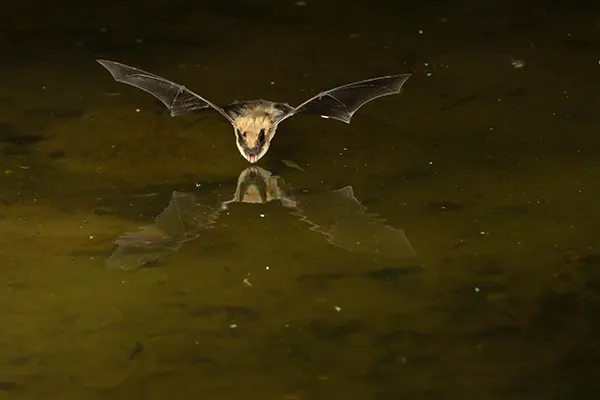Click To Call > (800) 966-7673
Wednesday, April 5, 2023
Bats, nature's flying fuzzy friends, usually don't get the best rap compared to other animals out there. Represented in pop culture as blood-sucking monsters, moody and sparkling teenagers, or dark and brooding crime fighters, the reality of these portrayals couldn't be farther from the truth.
With April 17 unofficially designated as International Bat Appreciation Day, Rose Pest Solutions, the nation's oldest family-owned pest management company, is taking a moment to highlight some interesting facts about bats and the important role they play in the ecosystem.
Bats Come in Many Shapes and Sizes The largest in the world is the giant golden-crowned flying fox, which is found in the Philippines and has a wingspan of up to 6 feet and can weigh up to 2.6 pounds, while the smallest is the bumblebee bat also known as Kitti's hog-nosed bat - which weighs in at only about 0.07 ounces and has a wingspan of about 6 inches and roosts in caves in Thailand and Myanmar.
"Michigan, Ohio, and Indiana are home to a few different species of bats, but they aren’t nearly as large as some found elsewhere," stated Dale Hodgson, regional technical manager for Rose Pest Solutions. "The hoary bat, which has an average wingspan of about 15 inches, is the largest in our region, while the smallest is the tricolored bat with a wingspan measuring in at just over 9 inches."

Being Blind as a Bat isn't as Bad as it Seems
Whether someone is clumsy, short-sighted, or legitimately hard at seeing, they’ve probably been called “as blind as a bat before.” When looking at the truth though, this saying may not hold as much strength as it seems. Most bats do not have the sharp, clear vision found in humans and other animals, but they are not completely blind, as the insult alludes to.
"All bats, including those found in Michigan, Ohio, and Indiana, like the hoary, little brown and big brown bat, possess small eyes and are fully capable of sight," said Hodgson. "However, given that they spend most of their time in darkness, they rely primarily on echolocation to help with navigation at night due to the pitch-black dark."
Most Bats Do Not Suck Blood
Despite what Dracula and the Twilight book series taught the world, almost no bats suck blood - with many preferring fruits or a large tasty helping of insects. Only three species of bats consume blood - the common vampire bat and its two cousins, the white-winged and hairy-legged bat.
"The species of bats that primarily rely on blood for sustenance aren't found in The United States or Canada," added Hodgson. "The various species of vampire bats are primarily found in Mexico, Central America, and throughout South America."
Even the Smallest Bats Eat Quite a Bit
On the topic of their diet, bats of even the smallest size have quite an appetite. Even the little brown bat, which measures about the size of an adult human’s thumb, can eat 4 to 8 grams in a single night – a massive amount for its size. The amount of food bats consume is so staggering that findings by the United States Geological Survey estimate that the loss of close to one million bats in the Northeast U.S. may have resulted in 660 and 1,320 metric tons of insects no longer being eaten in a single year.
“In our region, bats mostly consume insects like night flying beetles, stink bugs, mayflies, lacewings, and occasionally moths” stated Hodgson. “Their eating habits play a key role in keeping insect populations in check and stable.”
Bat Populations Grow Slowly and Are Threatened
Bats have some things in common with humans, they are warm-blooded, have hair or fur, and give birth to live young. Referred to as pups, bats will only give birth to a single offspring at a time – which means it takes time to grow their population. This fact is complicated by habitat reduction and diseases like White Nose syndrome which threaten populations across the country, not only causing trouble for our flying friends of the night but also the species they share their ecosystems with – including humans.
"White Nose threatens millions of bats in multiple states, including Michigan, Ohio, and Indiana - leading to a severe decline in overall populations nationwide," Hodgson stated. "When addressing a situation involving a bat, Rose Pest Solutions always prioritizes exclusion to help preserve and protect existing numbers in the region. All bats are protected but three are endangered; the Indiana, northern long-eared, and tri-colored bat. Little brown bats are under consideration for endangered status because their populations have been decimated by White-Nose Syndrome.”
What to Do When a Bat Enters Your Home?
When a bat enters your residence, always consult a professional due to the risk of exposure to rabies and further potential harm that can come to both parties.
When called about a bat, Rose Pest Solutions follows National Wildlife Control Operators Association best practices - which include a focus on exclusion during the warmer months of the year when bats are active but after the pups are reared and flying on their own. During the colder months, the pest management company will not remove a bat from a structure unless it’s in direct contact with humans in an occupied residence due to the vulnerability of their populations.
As part of its exclusion measures, Rose Pest Solutions will:
Homeowners should pay attention to small cracks and crevices and other openings that bats can enter through. They should also ensure that bat homes are properly positioned in an area most suitable for bats – somewhere that is quiet, shady, and away from an occupied structure.
Click Here for tips and more information about Rose wildlife management services.